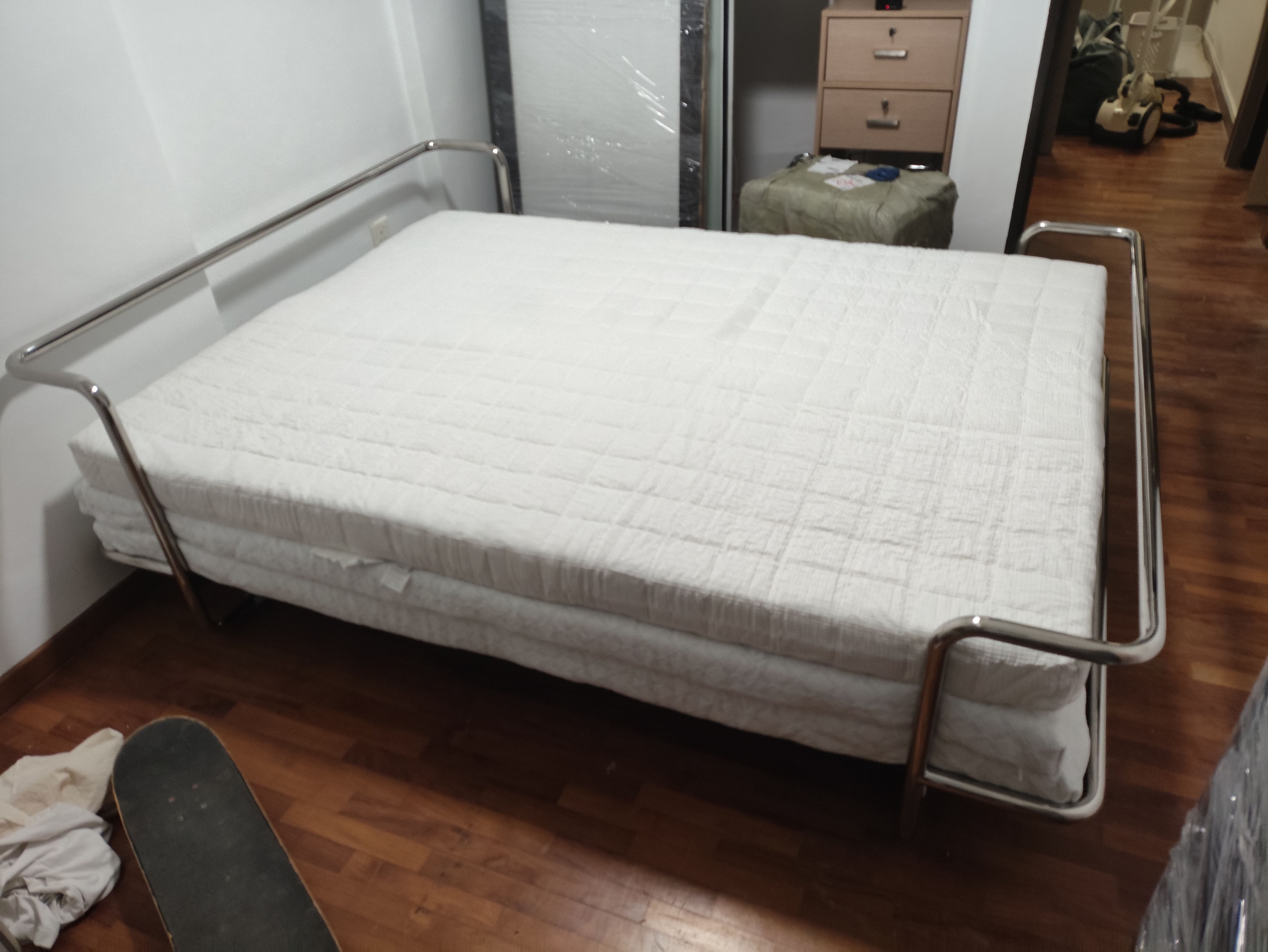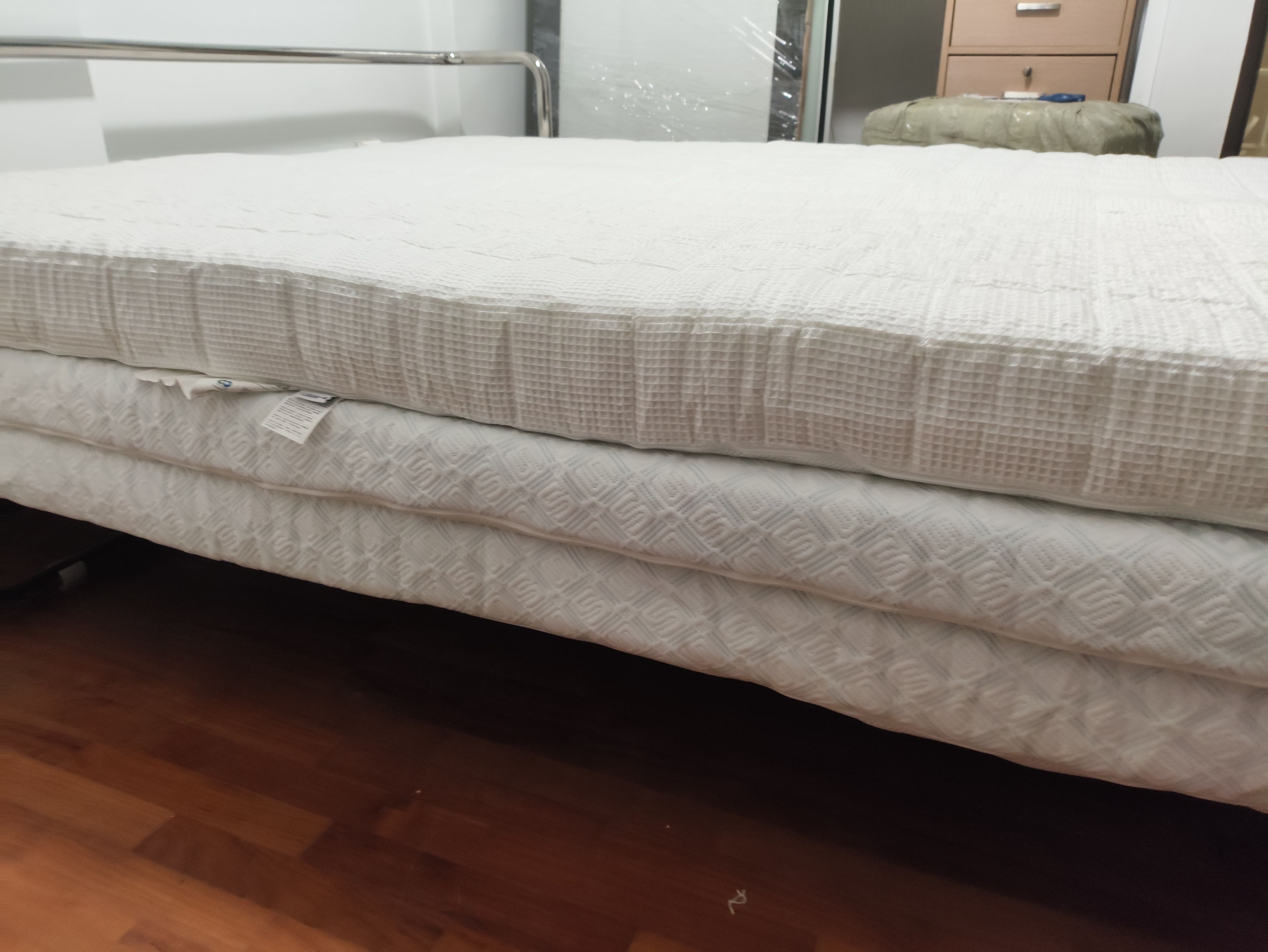DIY Mattress Making
I moved house in 2025, and decided it'd be a good time to throw away my old, piss-stained (my cat's, I swear!) single-sized mattress. I thought this would be the perfect time to do a little research on what makes a good mattress, and meaningfully replace my old mattress.
Just previously, I had been thinking of sleeping on a futon-type thing to save a bit of floor space too. While it's still tempting, I don't think I'd actually get used to folding it up daily.
I came across a YouTube video on my Twitter feed which I watched in full one weekend afternoon. He gave some compelling arguments.
TL;DR, Get a latex mattress, or memory foam if you have to. Absolutely avoid coils.
Another TL;DR: There are two main types of latex mattresses based on the chemical process used to make them. The typical one is Dunlop, with Talalay latex being a more complicated and thus expensive process.
The Talalay process confers some properties to the latex that may be preferred: most say softer, more breathable. A lot of mattress store websites have an article on the difference[1].
Findings
In short, my search came up disappointing. Among the companies I searched, none* had Talalay latex.
Furthermore, many salespeople did not even know the difference. At one place where I inquired, the sales lady opened her laptop to find that they were given a document with info on Dunlop vs Talalay, which she had never needed to read before.
Even though Singapore is situated amongst sprawling rubber plantations in Southeast Asia, I could not find companies in the area that supplied Talalay latex, not even in Thailand or Malaysia.
Understandably, the process itself is more expensive, and I don't suppose there's much demand in the area.
The US stores don't ship to Singapore. If you really wanted to, you could ship them yourself through a forwarding service. Likewise with the Vitalalay factories in Europe. This would probably be the option that guarantees the most reliable results.
* There were some places selling Talalay Latex toppers, or their mattresses included a thin layer of Talalay Latex. See below.
Decent local brands if you're okay with Dunlop

A few brands I shortlisted in my find were decent, but mostly have Dunlop latex. If you don't really find the difference between Talalay and Dunlop to be that big of a deal, you could just buy one of these here.
-
Heveya, while expensive, is B Corp certified and is fully transparent about their mattress makeup, which is 100% Dunlop latex, no frills. I liked their presentation, and they get my vote for their commitment to sustainability, transparency.
-
Sofzsleep is the budget option which also offers 100% Dunlop latex mattresses. They offer many different mattresses, but I can't really tell the difference between any of them. Maybe it's the thickness? Nonetheless, you can check them out in-store at the Mattress Boutique to find out more. Value for money option.
-
Getha's mattresses are Dunlop based on their website's info, but they also sell Talalay pillows, and some of their mattresses reportedly have a layer of Talalay in-between. Mid-ranged prices here.
-
Dunlopillo, which is probably an industry leader, has this "Talasilver wave" mattress layer which I assume is based on Talalay. These make up the comfort layer of some of their products, and the remaining layers are foam or I assume Dunlop latex. They also sell Talalay latex toppers, in case you only need the topmost/comfort layer to be Talalay, this is a reliable option too, being an established name.
-
Woosa gets a special shoutout in this section. Their mattresses do have latex on the top layers, otherwise they're filled with foam and some coils. They also claim to use a layer of Talalay, although from what I see it's really thin. I know, because they present their cross-sections in the stores, which is absolutely what every mattress brand should do for full transparency. This brand gets my vote because I laid on their mattresses in-store and they were extremely soft and comfortable.
The Conclusion
I was hell-bent on getting a Talalay mattress, if only just to see what the fuss is about. In the name of science!
In the end, I looked to Taobao, which is probably the best place to look. I didn't want to concede just yet, and thought maybe I could actually DIY something inexpensive.
Another poster on the Mattress Underground shared the same difficulty finding Talalay latex mattresses in Singapore, and even the ones on Taobao couldn't be truly verified.
Nonetheless, they made the purchase a year ago, and are reportedly satisfied with the product. They even supplied the name of the store they bought from, which saved me a bit of comparing around.
The subsequent sections deal with my experience after receiving the mattress.
Doing it Myself
Ordering the parts
I bought a total of three mattress layers off Taobao, all in queen size (150 by 200cm).
The Talalay layer, intended for the topmost layer[2] of the mattress, was 10cm thick and cost about ¥6800. Supposedly, this was imported from Vitalalay.
The other two layers, I bought Dunlop layers at different "deflection"[3]. Each was 7.5cm thick, and I got 85D and 95D at ¥1330 and ¥1700 respectively.
Total costs chalked up to about ¥8200, or S$1465, or US$1146, the majority of which was the price of the Talalay layer. Oh, and this price was not inclusive of shipping fees and import taxes, which were another few hundred.
I also got a mattress cover/protector and some bedsheets. There are some considerations here as well. Without going into too much research, I got an unquilted cover[4] that claimed to be waterproof (in case my cat pees on my bed again), and I got HOOGA Cara cotton sateen bedsheets[5].
Assembly
The mattresses in their entirety arrived about a month after I had initially ordered. With the mattresses shipped, it was time to start assembling the layers.
For the bedframe, I got a queen-sized replica of the KROMVIK, which fit the mattress height just nicely. Taobao truly is amazing.
Overall, it didn't take very long, but the mattresses were heavy, or rather unwieldy. I think I also received extra pillows from the store, which is nice.
Review
Here's how it looked like in the end, before I wrapped it up with the covers. All the mattress layers arrived with their own covers.

I was eager to start sleeping on this bed already. These past few months, I had been sleeping on a hard mattress on the floor as a temporary arrangement, so I had something to compare against.
My first night, I was pleased with the amount of space I had. I don't know how I slept on a single bed before, I must've always had a limb or two jutting out at any given time.
First, I noticed that it's soft, but not bouncy. If I jumped on it, I wouldn't fly, I'd just sink into it.
It was a pain to align the layers flush due to their heftiness. I decided it was not worth the effort and zipped it all up in a cover, with much effort.

The latex mattress fit the curves of my body well. As a side-sleeper, I require more support as the body tends can bend laterally, in more extreme ways than sleeping on the back. Check out this article on recommended support.
On that note, pillow size also matters in supporting your head in the various positions.
Not to brag, but harder mattresses were unable to support my musculature, especially my thighs, which are larger and harder than average. They were always a source of discomfort whenever I decided to sleep in an unorthodox position (on the stomach), in which I lay with my thighs facing down instead of facing up.

Overall, you can never really tell whether a mattress is good or not, as it's something you really only know after years of sleeping on it. Still, it's a step above what I've been sleeping on, and I think I got more than my money's worth, so I'm pleased!
The layers of a mattress include the comfort layer, which is the topmost, softest one, and the support layer, which is firmer at the base. In-between, you may find a transition layer. In general, the mattress goes from soft to firm as you go down. Some more information ↩︎
When discussing mattress firmness, a measurement called Indentation Load Deflection or ILD is used. Each store's deflection can only really by compared against itself, so I'm guessing 85D is less firm than 95D. ↩︎
I haven't done much research on the differences, but from what I gather, the differences include softness and temperature circulation. Quilted covers may be firmer, less stretchy, but offer better breathability. ↩︎
A friend recommended Tencel/Lyocell sheets, and I was considering linen or bamboo, but I decided cotton was the simplest way to go. Many recommend Egyptian cotton or cotton sateen. Of course, I don't go for synthetic fibres. ↩︎